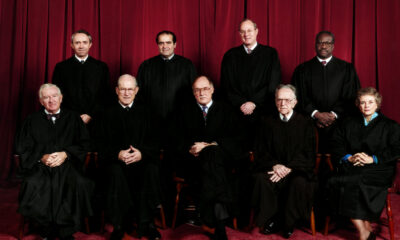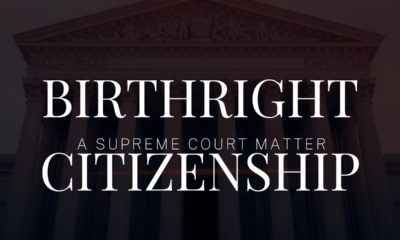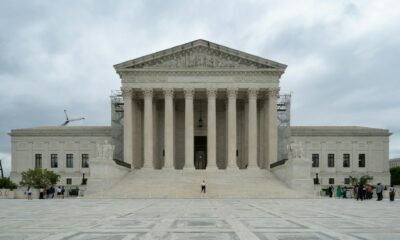Constitution
A strike has its limits
The Supreme Court, in Glacier Northwest v. Teamsters, set limits on protected strike activity, specifically excluding deliberate sabotage.
Labor relations, with the passage of the National Labor Relations (“Wagner”) Act, became a lawless affair. This Act invented a new right – the right to strike. But to strike meant more than simply to stop work. According to the Wagner Act, a labor union acquired a near-absolute right to stop work, at any time, regardless of an employer’s economic interest – any economic interest.Yesterday the U.S. Supreme Court took a small step toward restoring rule of law to labor relations. The Court held that, when a union calls a strike at a time that creates a damaging and potentially dangerous situation, even the Wagner Act does not protect the union or its members from civil liability for property damage or destruction that they should have anticipated, and taken reasonable precautions to prevent. But, scandalously, the Court’s newest member wants to let unions go on wantonly destroying an employer’s property during a strike.
A primer on handling ready-mix concrete
Glacier Northwest, Inc., also known as Calportland, of Seattle, Washington, makes, sells, and delivers ready-mix concrete. The International Brotherhood of Teamsters represents all drivers of their ready-mix trucks. These are the trucks with the giant, bulging, rotating drums familiar to anyone who has ever driven the streets of a city with an active economy with lots of building construction activity.
Concrete, left to itself, hardens – or else it would be useless to anyone. A ready-mix truck keeps the concrete agitated in its rotating drum, but even that won’t last forever. Furthermore, a seller of ready-mix cannot mix or “batch” concrete until a truck is ready to load it. That truck must then drive by the fastest route to a customer’s site to offload the mix. If that does not happen soon enough, the concrete will harden inside the drum. Removing that hardened concrete is an orders-of-magnitude tougher job that usually involves crawling into the truck and using jackhammers. (LinkedIn carries an advertisement for an instrument called the Bridgeport ReadyJet® that can clear such a drum in ninety minutes. But that advertisement dates after the events in question.)
The Glacier Strike – facts alleged in the complaint
The opinion in the case (Glacier Northwest Inc. v. Int’l Brotherhood of Teamsters Local 174, 598 U.S. ___ (2022)) sets forth certain allegations by the company – allegations the seriousness of which one cannot overestimate.
In the summer of 2017, the labor contract between Glacier and the Teamsters expired. Negotiations then began – and broke down.
On August 11, 2017, Glacier had scheduled a large number of deliveries. So they started “batching” concrete, loading it into ready-mix trucks, and sending the trucks out to deliver their loads. After at least sixteen trucks had gone out onto the road, the union agent called the strike. Glacier ordered all drivers then on the road to finish their deliveries – but the union agent countermanded those orders.
Whether on the orders of the union agent, or because the drivers didn’t know what else to do, those drivers returned to the company plant with their loads. Seven of the drivers “parked their trucks, notified a company representative, and either asked for instructions or took actions to protect their trucks.” We do not know what those actions were – perhaps they involved wetting down the load to forestall hardening. But the other drivers parked their trucks, then got into their personal vehicles and left the plant. And they did this without leaving word with anyone.
Justice Amy Coney Barrett, writing for the Court, described what happened next:
Glacier faced an emergency. The company could not leave the mixed concrete in the trucks because the concrete’s inevitable hardening would cause significant damage to the vehicles. At the same time, the company could not dump the concrete out of the trucks at random because concrete contains environmentally sensitive chemicals. To top it all off, Glacier had limited time to solve this conundrum.
A mad scramble ensued. Glacier needed to determine which trucks had concrete in them, how close the concrete in each truck was to hardening, and where to dump that concrete in an environmentally safe manner. Over the course of five hours, nonstriking employees built special bunkers and managed to offload the concrete. When all was said and done, Glacier’s emergency maneuvers prevented damage to its trucks. But the concrete that it had already mixed that day hardened in the bunkers and became useless.
The lawsuit and aftermath
The next set of facts, one must glean from the opinion of the court and Justice Ketanji Brown Jackson’s dissent. Glacier sent disciplinary notices to the drivers who simply parked their trucks, got into their personal vehicles, and left. The union filed an Unfair Labor Practice grievance against Glacier with the National Labor Relations Board (NLRB, or “The Board”). Glacier then sued the union, seeking to recover the cost of the lost concrete mix components. They alleged that the ruin of the concrete batches constituted “common-law conversion and trespass to chattels.” So the union filed another Unfair Labor Practice grievance with the Board on account of the lawsuit.
The Teamsters moved to dismiss, citing a precedent (San Diego Building Trades Council v. Garmon, 359 U.S. 236,235 (1959)) according to which strike activity is the exclusive province of the Board and outside the jurisdiction of the federal courts or the relevant State courts. The trial court agreed, but the immediate court of appeal reversed the trial court’s decision. So the case came to the Washington Supreme Court. They held the concrete loss “incidental to a strike,” so the company had to suck it up. 198 Wash. 2-d 768, 774, 500 P. 3-d 119, 123 (2021).
Consequently, Glacier petitioned the Court for review, on the question of:
whether the NLRA preempts Glacier’s tort claims alleging that the Union intentionally destroyed its property during a labor dispute.
The issue: when does a strike go too far?
No trier of fact has even judged whether Glacier’s allegations are true or false. Nor does even the union dispute that the Wagner Act does not protect all conceivable strike activity. At issue here, strikers must take “reasonable precautions” to protect employer’s property from damage that:
- They could or should reasonably foresee would happen from their sudden stoppage of work,
- Their actions would make worse (the legal term is “aggravated”), and
- Would happen immediately (the legal term is “imminent”).
The union as a body knew all the hazards of handling concrete, that CNAV has set forth above. In calling the strike when they did, they guaranteed that the company would lose all the components that go into a concrete mix or mixes. Worse, they risked putting sixteen or more trucks out of action and necessitating a remedy that would put workers at serious hazard. The ReadyJet® ad lists those hazards: falling debris, silica dust exposure, hearing loss, repetitive musculo-skeletal strain, working with a jackhammer blade, fatigue, and heat stress. But no information is available as to when ReadyJet® became available – or how well it really would work to clean out a ready-mix drum full of hardened concrete.
All of which to say: the Teamsters foresaw, or should have foreseen, a risk of serious damage to Glacier’s equipment.
A singular aggravating circumstance
But Justice Barrett went further. She found that the Teamsters set out to “create” a perishable good – the concrete. Worse, they deliberately planned to ruin several batches of concrete and even to damage as many trucks as they could. That follows logically from the assertions of fact in Glacier’s original complaint. The union agent told the drivers to return to the plant with their loads. Worse still, nine (or more) of those drivers abandoned fully loaded trucks without a word to anyone. Justice Jackson, in her dissent, alleges that the union agent instructed the drivers to “leave the trucks running.” But does to run necessarily mean to leave the drum rotating? Or does it merely mean to idle the engine? Deliberately ambiguous instruction could itself constitute a cause of action – reckless behavior at best, intentional sabotage at worst.
Sabotage – and worker-to-worker violence – has been a feature of strikes since the Wagner Act. The Kohler Strikes, especially the 1954-1961 strike, illustrate this. The NLRB never once sanctioned the union (United Auto Workers) for the violence they definitely did to non-striking workers. Indeed, Jack London (The Call of the Wild, White Fang) famously called for union violence as entirely appropriate.
Your editor can directly attest to both sabotage and violence at a strike – the strike of the Federation of University Employees, Local 35, against Yale University in the Fall of 1977. Union members did the worst of it, but some students got their licks in, too.
The majority opinion
Justice Barrett put together a five-member majority, of herself, Chief Justice John Roberts, and Justices Brett Kavanaugh, Elena Kagan, and Sonia Sotomayor. Separately, Justices Sam Alito and Clarence Thomas wrote concurrences in the judgment, in which Justice Neil Gorsuch joined. Justice Ketanji Brown Jackson dissented. Thus the Court ruled, eight to one, that the Glacier lawsuit over the strike could go forward.
Justice Barrett apparently approached this case as a trial judge might, if the plaintiff asked for a temporary injunction. Such a judge, after determining that the plaintiff will likely prevail on the merits, examines what follows from the plaintiff’s allegations. In this case, Glacier is alleging sabotage – deliberate and calculated.
Sadly, even some sabotage – like calling a strike when goods are likely to perish – actually comes under NLRB (“Board”) protection. But not, she says, when the union timed their strike to create a class of perishable good. Which is what they allegedly did in this case. So she held that even the Garmon precedent will not help the Teamsters here. The economic damage to the company went beyond loss of sale. They lost a great deal of raw materials, and almost lost sixteen or more trucks. (Again, one wonders whether even the ReadyJet® could have saved those trucks.) More to the point:
Because the union took affirmative steps to endanger Glacier’s property rather than reasonable precautions to mitigate that risk, the NLRA does not arguably protect its conduct.
Furthermore, she had a precedent to cite: Longshoremen v. Davis, 476 U.S. 380, 395 (1986).
Concurrences – and a dissent hinting at an absolute right to strike
Justice Thomas, concurring, wrote that, at least in future, the Supreme Court needs to reconsider the Garmon case. Justice Sam Alito wrote that, once the Court recognized that Garmon did not protect deliberate sabotage, “nothing more… needed” saying.
But Justice Jackson, alone among the nine, actually defended sabotage as legitimate strike activity. True, she didn’t go so far as to decide peremptorily that the company needed to “suck it up.” Instead she said the Board had jurisdiction, once the Teamsters had filed Unfair Labor Practice complaints with it.
Still, her dissent speaks volumes about a basic attitude, which she shares, that unions can do almost no wrong. One would almost assume that she relied on London’s “Definition of a Strikebreaker” (embedded above). The only reason not to suppose that, is that no one alleged that any Teamster physically assaulted anyone.
Everything she alleges to defend the Teamsters, is part of bad law, or flows from it. The Board, she says, can make its own findings of fact with regard to strike conduct. That puts this Board – this quasi-legislative, quasi-judicial, executive agency – in the position of judging tortious conduct. This demonstrably violates the Constitution. Judgment of tortious or criminally violent conduct has always been a State matter. Therefore this is a power “reserved to the States respectively, or to the people.” In short, Jackson fails to recognize that the Board is not and never can be a court of competent jurisdiction.
Justice Alito gives warning
Jackson recommended that the Washington Supreme Court
[o]n remand,… dismiss Glacier’s complaint without prejudice or stay its proceedings in view of the General Counsel’s complaint.
That complaint is before the Board. But this is a Biden Board, and as such would be likely to protect sabotage as legitimate strike activity. Perhaps recognizing that, Justice Alito offered this warning in a footnote in his concurrence:
The Court wisely declines to address the argument on which JUSTICE JACKSON relies regarding the effect of the complaint before the NLRB on this litigation. See post, at 7–8. That argument represents a striking extension of Garmon preemption, which, as the Court notes, is already an “unusual” doctrine. See ante, at 3–4. If the state courts on remand dismiss this case on that ground, the decision, in my judgment, would be a good candidate for a quick return trip here.
In other words: don’t even think about it! Do that and expect us to “grant cert” again and this time revisit Garmon and perhaps strike it down.
The legacy media and its radical strike advocacy
Of all the legacy media organs, Reuters has the least offensive coverage. They describe the Court as having “dealt yet another setback to organized labor” in their ruling. In their recital of the fact, they assume that the striking drivers kept the drums rotating on the trucks. As Justice Barrett noted, we don’t know that. In fact, most of the drivers left their trucks in the yard and told no one where they were. Furthermore, Reuters makes total light of the company having to “discard the unused product.” They said nothing of the environmental impact – and one can readily imagine that, as soon as the Sierra Club started screaming for scalps had the company not built the bunkers and did everything they could to contain the concrete, Reuters would have rushed to scream along with them.
Reports from USA Today and CBS News were worse. (CBS, back in January, clearly were afraid of this result.) They contended that this and other rulings would scare workers into not going on strike at all. That is hardly the case. Had they simply not reported for work that day, the company would have mixed no concrete and loaded no trucks. The company might then have lost some sales, and no one disputes that the workers had no contract. In fact, Vox took a far more measured stance, clearly showing that they read the opinion. They concluded that this decision raises more questions – that will require more litigation.
Toward a return to the rule of law
But American labor relations really need a return to the rule of law. Labor law should not permit workers to strew nails or tacks onto driveways and parking lots at the workplace. Which they did once at a strike at a forklift truck dealership in Elizabeth, New Jersey, in the 1980s. (Your editor has certain knowledge of that case.) Nor should labor law permit a worker to throw a nearly full glass gallon of gin through the windshield of a truck delivering fuel oil to a power plant. Which one worker did at the Yale Strike of 1977 – and The Yale Daily News celebrated his conduct.Nor should it permit any worker to smash equipment, wreck trucks, or – as in this case – ruin batches of concrete.
Yet it has always been fashionable on the political left to endorse sabotage in labor relations. (Jack London, of course, endorsed murder – an even worse stance.) Ketanji Brown Jackson is a part of this deleterious tradition – the more reason she should not sit on the Court. CNAV has noted before her tendency to rewrite the Constitution.
Still, Jackson’s presence as a member of the Court – indeed as a member of the Bar – is but a symptom of a larger problem in American jurisprudence, and American society as a whole. The rule of law simply lacks the respect it must have in a sound society. The decision in this case should have been unanimous. It isn’t – so there’s work to be done.
Terry A. Hurlbut has been a student of politics, philosophy, and science for more than 35 years. He is a graduate of Yale College and has served as a physician-level laboratory administrator in a 250-bed community hospital. He also is a serious student of the Bible, is conversant in its two primary original languages, and has followed the creation-science movement closely since 1993.
-

 Civilization5 days ago
Civilization5 days agoOn the 2025 National Security Strategy
-

 Civilization3 days ago
Civilization3 days agoIvory Tower Thinking and Narcotics Boats
-

 Executive4 days ago
Executive4 days agoWaste of the Day: Shockingly, Inmate Phone Calls Lead to More Criminal Activity
-

 Executive2 days ago
Executive2 days agoThe Last Supper: New York’s Socialist Feast
-

 Civilization2 days ago
Civilization2 days agoYoo Hoo, VP Vance—Your Character is Showing!
-

 Executive4 days ago
Executive4 days agoWH Ignores Demands From Pro Life Lobby To Fire FDA Commissioner
-

 Civilization4 days ago
Civilization4 days agoGeneral Misconduct: There Is an ‘I’ in Milley
-

 Civilization5 days ago
Civilization5 days agoIf Not a Musk, Then the Navy Needs Another Rickover














